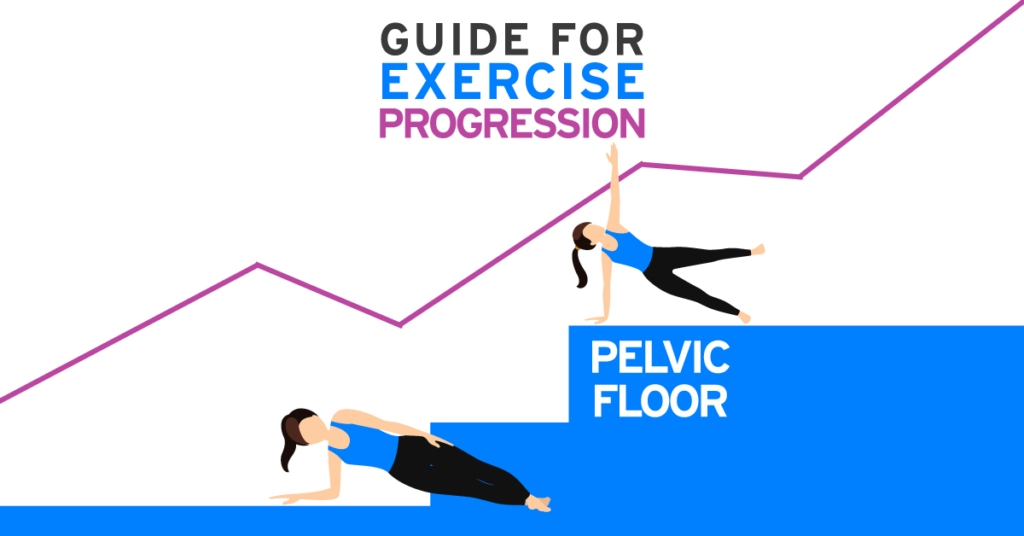The pelvic floor muscles sit in the middle of the body, inside our pelvis. This means, for better or worse, these muscles are impacted by all activities, exercises and movements. However, the pelvic floor muscles are often not considered when progressing an exercise or establishing the correct starting point with working out, which can lead to frustration with setbacks and slow gains toward your goals. For this reason, it is important to understand when, how and what to watch for with exercise progression, and to keep these things in mind for daily life activities. This exercise progression guide is for all people; pregnant, early or late postpartum, never postpartum, and decades postpartum. Follow the guide below:
No Breath Holding
Avoid holding your breath with activities in life and exercise. If you find that you tend to hold your breath, there could be a few reasons for it. Easiest fix, habit. You have created holding your breath with “difficult” activities as a habit, which can be corrected with awareness. Secondly, the activity or exercise is too difficult. Consider modifying to make the move easier. Our body will “ramp up” with breath holding to “create strength” with building up pressure. However, this comes at a cost. This excessive pressure has to go somewhere, which means it will push out on the weakest link; this could be your pelvic floor contributing to prolapse or leaking, your abdominal midline contributing to a hernia, or a spinal disc contributing to disc herniation. These are NOT good things. It is true that our body is “strongest” with breath holding, but this is due to the pressure build up and not related to true strength.
For similar reasons,
Avoid clenching your jaw and excessively tensing your hands and/ or shoulders.
Watch for Abdominal Doming
This is when your abdomen domes outward at the midline, it can be a little or a lot of bulging. This signals a disconnect in the inner core (deep abdominal muscles, pelvic floor and breathing). You will need to visibly watch for this. If you find this happening, you should back off. It is a clear sign that the exercise is too challenging and that you need more work on your inner core strength and/ or coordination of the inner core system.
Avoid Feeling Pressure Down on the Pelvic Floor or Vaginal Region
This means you need to stop and modify the activity. It could be a simple fix, such as not holding your breath. Or maybe the exercise itself is too challenging. This applies to all movements; bending, lifting, overhead lifting, pushing, pulling, push-ups, planks, squats, running, biking, etc. Poor pressure management is one of the major reasons I see clients with pelvic floor dysfunction. The ability to manage pressure upfront can also help to prevent pelvic floor dysfunction later in life.
Monitor Lower Belly Pooching
If your belly pooches outward during an activity or exercise, this signals a compromised inner core (breathing, pelvic floor muscles and deep abdominal muscles).
Watch Form
It is important to know which muscles you should be working with a particular exercise. It is easier to safely and correctly make an exercise more challenging when you understand which muscles should be working. In this way, if you feel the wrong muscles, you know something is wrong. It is helpful to use a mirror or forward facing camera to watch yourself perform the exercise to be certain you are actually doing what you feel like you are doing. This can be especially helpful in the early postpartum period (< 4-5 months) as you are getting reacquainted with your body without carrying a baby.
Avoid Pain
Do NOT push through pain. It will not get better; something is wrong. It could be an easy fix, such as working on mobility before the particular exercise. But I promise, if you push through, it will be a longer road to recovery. This could be pain during the exercise itself, but also monitor how you feel after the exercise. If you hurt more than muscle fatigue, modify the exercise to help prevent breakdown and issues in the future.
No Peeing, Tinkling or Dribbling Urine
This signals a breakdown in the inner core, meaning the system is not ready to handle that level of activity. This could be the running distance, level of resistance with weight lifting, duration or intensity of the activity. Peeing with exercise does NOT equate to a good workout. Think of peeing or leaking urine similar to knee pain; it signals a system breakdown and a problem that should not be ignored. If a certain activity caused knee pain, hopefully you would listen to your body and back off; this is the SAME for leaking urine.
Summary
Keep in mind that the body is resilient. If you mess up, push too hard, or go too far, it will be okay; the body can typically recover with the appropriate help and rest. This list is to help guide you to appropriately progress your exercise and achieve your goals. Starting at a level of exercise that is too challenging can result in injury and setbacks, which is frustrating. Instead, start at the appropriate level, using this guide to progress exercise with confidence to avoid setbacks. You will achieve your goals more quickly when you listen to your body versus “pushing through”. Every person is different, and generalized timelines can be dangerous for this reason. It is more important to stay diligent, listen to how you feel, and use this guide for progressing exercise. To make gains, you should challenge your body; but the key is to match what your body is able to handle.
Regardless of your fitness goals, we need to be strong for life. We need to be strong to lift our toddler onto the play gym, push the grocery cart through snow to the car, lift our babies into the car seat, take the turkey out of the oven, and a hundred other things. Life requires you to be strong, and for better or worse, your body will accomplish these activities. My hope is that you are equipped with the understanding of optimal movement strategies and strong enough for life to avoid back pain, pelvic floor dysfunction, shoulder pain, hip pain, etc.
This was a guest blog by Angela Turnow, DPT, PCES.


